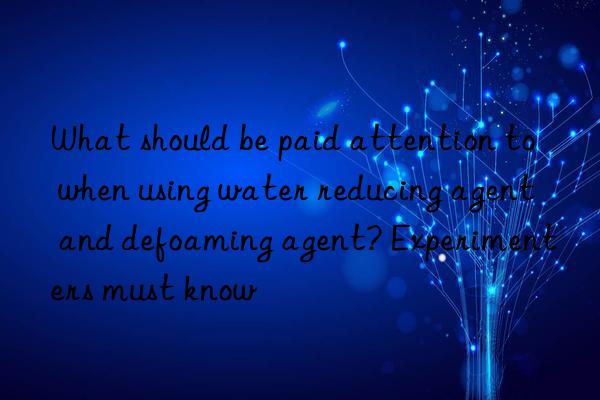
Practitioners in the construction industry have a common feeling in recent years: concrete is particularly prone to bleeding and large segregation slump. In actual construction, the quality requirements for concrete are getting higher and higher, and the requirements for admixtures added to concrete are also getting higher and higher, especially for the performance requirements of water-reducing agents, whose high water-reducing rate, Good dispersion properties and plasticity retention allow it to quickly expand its application areas. However, when water-reducing agents are added to concrete, due to the characteristics of the molecular structure, more bubbles are introduced during concrete mixing, with uneven sizes and small pores on the surface. , affecting the quality and strength of concrete, the workability of concrete must be improved by adding water-reducing agents and defoaming agents to meet production needs.
Using water-reducing agent and defoaming agent can eliminate excess large bubbles in the concrete, making the appearance of the concrete more beautiful and stronger. It can also reduce the air content of the water-reducing agent and improve the quality of the concrete. The pore structure and density improve the strength and quality of concrete.
1. When using water-reducing agent to produce concrete, adding defoaming agent can reduce the air content of the water-reducing agent and increase the viscosity of the concrete slurry. Therefore, after adding defoaming agent, some air-entraining agent should be added.
2. Since the water-reducing agent is involved in the production process, other surfactants will also be added. These surfactants contain alkaline, so the defoaming agent used must have the performance of defoaming and suppressing foam, and it must also It has the characteristics of resistance to high temperature, strong acid and strong alkali.
3. The defoaming agent has good compatibility with water and other surfactants, and has good dispersion performance. However, it is easy to cause separation after being placed for a long time, so when using the defoaming agent, Do not leave it for too long or stir continuously during this period to avoid separation.
Issues that need to be paid attention to during the trial process of using defoaming agents for water reducing agents:
1. Consider whether the defoaming agent system is compatible with your own system?
First of all, you have to consider whether the defoaming agent system is suitable for your industry. Because defoaming agents are divided into oil-based and water-based defoaming agents, different defoaming agents are used in different industries.
Secondly, you need to consider the amount of alcohol or organic solvent in the system. Because it is everyone’s consensus that alcohol has a defoaming effect, it sometimes has some interference effects.
2. Applicable PH range of defoaming agent.
Strong acid and alkali environments have strict requirements on defoaming agents. This requires explaining the carrier environment to the defoaming agent manufacturer.
3. Consider the long-term effectiveness of the defoaming agent.
Some defoaming agents are very good at first, but the effect becomes much worse after being left for a period of time.
There are many influencing factors, at least two reasons:
1) The defoamer is compatibilized by the surfactant,
2) The main agent of the defoamer Can be absorbed by colloidal resin.
4. Defoaming ability under static conditions.
When the liquid that generates bubbles flows back into the storage tank or directly into the packaging barrel, it is okay if the defoaming is fast.
5. Defoaming ability under dynamic conditions
1) Dynamic defoaming effect in relatively closed small spaces. Because it involves gas entering the bubble, the external air pressure decreases in a short period of time, which is more conducive to the generation and stability of the bubble. Wetting agents and emulsifiers have a shrinking effect on the gas in the bubbles. One is nothing, but tens of millions are considerable.
2) To activate the dynamic defoaming effect, the single-sheet flexo printing machine is transformed into a glazing machine, and the small space of the upper rubber roller and inking roller is exposed and rotates at a high speed, causing bubbles to be generated very quickly.
6. Applicability on the machine
1) Temperature. Temperature changes lead to changes in surfactant foam stabilization and defoaming.
2) Customer habits.
The above are the things that should be paid attention to when using water reducing agent and defoaming agent. I hope everyone will remember the precautions and never be careless!
</p



 微信扫一扫打赏
微信扫一扫打赏
